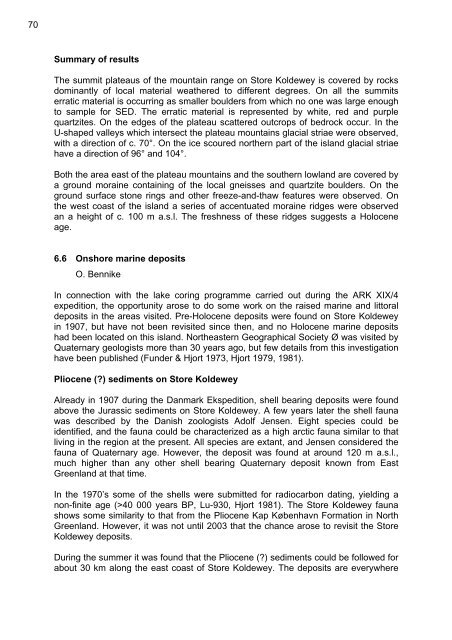the Expedition ARKTIS-XIX/4 of the research vessel POLARSTERN ...
the Expedition ARKTIS-XIX/4 of the research vessel POLARSTERN ...
the Expedition ARKTIS-XIX/4 of the research vessel POLARSTERN ...
You also want an ePaper? Increase the reach of your titles
YUMPU automatically turns print PDFs into web optimized ePapers that Google loves.
70<br />
Summary <strong>of</strong> results<br />
The summit plateaus <strong>of</strong> <strong>the</strong> mountain range on Store Koldewey is covered by rocks<br />
dominantly <strong>of</strong> local material wea<strong>the</strong>red to different degrees. On all <strong>the</strong> summits<br />
erratic material is occurring as smaller boulders from which no one was large enough<br />
to sample for SED. The erratic material is represented by white, red and purple<br />
quartzites. On <strong>the</strong> edges <strong>of</strong> <strong>the</strong> plateau scattered outcrops <strong>of</strong> bedrock occur. In <strong>the</strong><br />
U-shaped valleys which intersect <strong>the</strong> plateau mountains glacial striae were observed,<br />
with a direction <strong>of</strong> c. 70°. On <strong>the</strong> ice scoured nor<strong>the</strong>rn part <strong>of</strong> <strong>the</strong> island glacial striae<br />
have a direction <strong>of</strong> 96° and 104°.<br />
Both <strong>the</strong> area east <strong>of</strong> <strong>the</strong> plateau mountains and <strong>the</strong> sou<strong>the</strong>rn lowland are covered by<br />
a ground moraine containing <strong>of</strong> <strong>the</strong> local gneisses and quartzite boulders. On <strong>the</strong><br />
ground surface stone rings and o<strong>the</strong>r freeze-and-thaw features were observed. On<br />
<strong>the</strong> west coast <strong>of</strong> <strong>the</strong> island a series <strong>of</strong> accentuated moraine ridges were observed<br />
an a height <strong>of</strong> c. 100 m a.s.l. The freshness <strong>of</strong> <strong>the</strong>se ridges suggests a Holocene<br />
age.<br />
6.6 Onshore marine deposits<br />
O. Bennike<br />
In connection with <strong>the</strong> lake coring programme carried out during <strong>the</strong> ARK <strong>XIX</strong>/4<br />
expedition, <strong>the</strong> opportunity arose to do some work on <strong>the</strong> raised marine and littoral<br />
deposits in <strong>the</strong> areas visited. Pre-Holocene deposits were found on Store Koldewey<br />
in 1907, but have not been revisited since <strong>the</strong>n, and no Holocene marine deposits<br />
had been located on this island. Nor<strong>the</strong>astern Geographical Society Ø was visited by<br />
Quaternary geologists more than 30 years ago, but few details from this investigation<br />
have been published (Funder & Hjort 1973, Hjort 1979, 1981).<br />
Pliocene (?) sediments on Store Koldewey<br />
Already in 1907 during <strong>the</strong> Danmark Ekspedition, shell bearing deposits were found<br />
above <strong>the</strong> Jurassic sediments on Store Koldewey. A few years later <strong>the</strong> shell fauna<br />
was described by <strong>the</strong> Danish zoologists Adolf Jensen. Eight species could be<br />
identified, and <strong>the</strong> fauna could be characterized as a high arctic fauna similar to that<br />
living in <strong>the</strong> region at <strong>the</strong> present. All species are extant, and Jensen considered <strong>the</strong><br />
fauna <strong>of</strong> Quaternary age. However, <strong>the</strong> deposit was found at around 120 m a.s.l.,<br />
much higher than any o<strong>the</strong>r shell bearing Quaternary deposit known from East<br />
Greenland at that time.<br />
In <strong>the</strong> 1970’s some <strong>of</strong> <strong>the</strong> shells were submitted for radiocarbon dating, yielding a<br />
non-finite age (>40 000 years BP, Lu-930, Hjort 1981). The Store Koldewey fauna<br />
shows some similarity to that from <strong>the</strong> Pliocene Kap København Formation in North<br />
Greenland. However, it was not until 2003 that <strong>the</strong> chance arose to revisit <strong>the</strong> Store<br />
Koldewey deposits.<br />
During <strong>the</strong> summer it was found that <strong>the</strong> Pliocene (?) sediments could be followed for<br />
about 30 km along <strong>the</strong> east coast <strong>of</strong> Store Koldewey. The deposits are everywhere

















